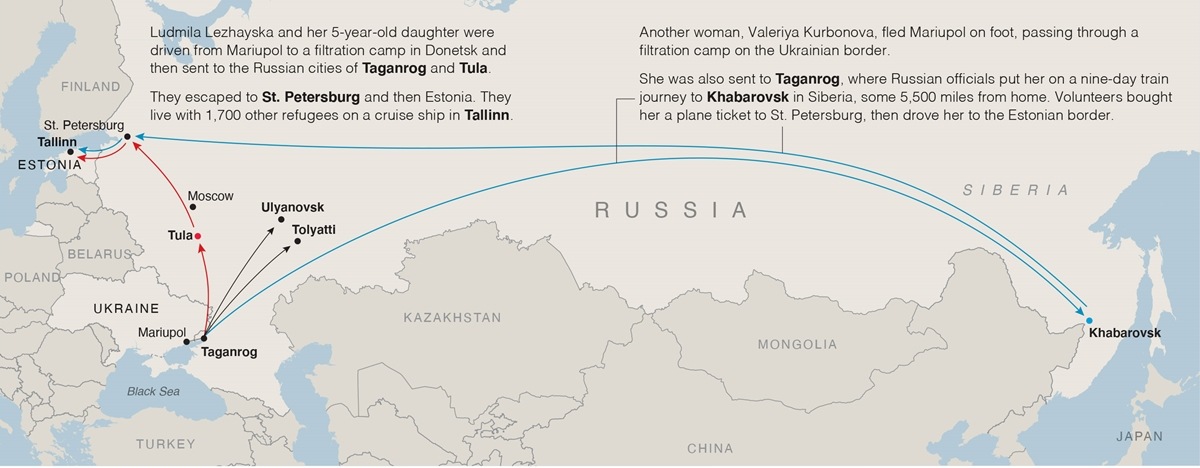
Since the invasion of Ukraine in late February, hundreds of thousands of Ukrainians have been forcibly resettled in Russia.
In interviews with The New York Times, a dozen people who escaped described a process known as “infiltration,” part of a Russian campaign to “de-Zazify” and “disarm” Ukraine.
After surviving the war, dozens of Ukrainians were expelled from their hometown of Mariupol and taken to camps where they were harshly interrogated. They were then sent to facilities as far away as Siberia and the Pacific coast, and pressured to take Russian citizenship.
Since the invasion of Ukraine in February, hundreds of thousands of Ukrainians have been forcibly resettled in Russia. (NYT)
Many said they felt trapped: robbed of a home and forced thousands of miles deep into enemy territory.
Ludmila Lezhayska and her 5-year-old daughter, Masha, were able to leave Russia for a new temporary home: a ship in the port of Tallinn, the capital of Estonia. They shared cabins on the cruise ship with about 1,700 neighbors, all of whom had fled the war in Ukraine.
For almost everyone the Times spoke to, the arduous trek to Estonia began in the shell-strewn remains of Mariupol, which Russia besieged for two months before taking full control in April.
Lezhayska and her neighbors hid in the basement of her apartment block for almost a month, then Russian soldiers told her they had to leave.
“My son is walking, dirty, 5 years old. This girl lived in a cellar for a month,” he said. “A Russian tank pulls up and a Russian soldier comes out and gives my son bread.
“I can’t describe my feelings, everything that was inside me. I say: ‘Thank you’. But thank you why? To destroy my house? My life?”
Nadya Ponomaryova described the moment Russian troops arrived at her building.
“Soldiers entered our basement in the morning,” he said. “They took some of the young men outside. They put them on their knees, blindfolded them and tied their hands.”
Russian forces put special scrutiny on the men, seeing them as potential combatants. There is evidence that Russian troops have routinely detained, and even killed, those suspected of even loose affiliation with Ukrainian forces.
“All the men who were there took us to the courtyard and ordered us to disrobe,” said Ihor Tarashchiansky. “They were looking for tattoos. Checking if we were military. And we couldn’t even feel that we were undressed by the cold. It was quite cold then, but it was a shock. This state of fear.”
Eduard Mkrtchyan was seriously injured when his apartment block was bombed. But Russian forces saw his wound as a sign that he might be a fighter.
 Infiltration camps in Ukraine (NYT)
Infiltration camps in Ukraine (NYT)
“Three giant 6-foot-tall Chechens are pointing their machine guns at me. I’m lying down and I can’t move,” Mkrtchyan said. “I tell them: ‘Don’t shoot, I’m wounded.’ They probably thought he was a Ukrainian soldier that people had hidden.”
Lezhayska and everyone else the Times spoke to described how residents were driven to the outskirts of Mariupol to so-called infiltration camps. These are sites throughout the Donbas region with the purpose of identifying anyone the Russians consider a potential threat.
Inside the camps, people described interrogation, days of waiting and harsh treatment. Those who pass this part of the process receive documents indicating that they have been fingerprinted.
They are taken to a train station in the Russian city of Taganrog, just across the Ukrainian border. They are then sent elsewhere. His arrival is being celebrated in front of local television cameras as an example of Russia’s humanitarian efforts.
Refugees described a system with no personal choice about their final destinations.
Valeriya Kurbonova had the longest journey of the refugees the Times interviewed. He fled Mariupol on foot and passed through an infiltration camp in the Ukrainian border town of Novoazovsk. She was sent to the Taganrog train station, where emergency officials told her to board a train to Khabarovsk, a city on Russia’s border with China.
“We spent nine terrible days on the train,” Kurbonova said. “Every day we woke up to find ourselves still on the train.” She was housed in a large sports facility in Khabarovsk, more than 5,000 miles from home.
Some of the resettlement facilities in Russia restricted the movement of Ukrainians or banned visitors. Others were so far away that there was no practical way to leave.
Officials strongly encouraged newcomers to apply for Russian citizenship. The process forced them to surrender their Ukrainian passports.
“I found out it means you can’t leave Khabarovsk for three years,” Kurbonova said. “So I told them, ‘I’m not doing the passport. I refuse'”.
After 20 days in Russia, Lezhayska was able to scrape together enough money for train tickets to St. Petersburg, and she and her daughter were driven from there to the Estonian border.
Ukrainians in Estonia are among the few who have managed to leave Russia: the vast majority have been unable to escape the country that launched a brutal campaign of conquest against their homeland.
This article originally appeared in The New York Times.

